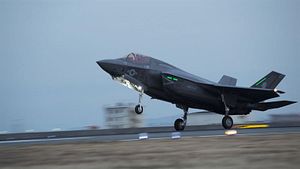How deeply are Australia’s naval aviation acquisition plans set in stone? With the F-35A on the verge of appearing at the Avalon Air Show, debate over the appropriate version of the Joint Strike Fighter continues.
Australia is purchasing the F-35, and Australia has already acquired two aircraft carriers capable (with modifications) of operating the F-35B. Two years ago, the government conducted a study to examine the potential for purchasing the F-35B and modifying the two Canberra-class amphibs (built in Spain to the same design as the Juan Carlos I), but eventually rejected the proposal as too costly, and too detrimental to other naval objectives.
But the debate continues, and as Australia’s strategic situation seems to be in flux (not least because of the election of U.S. President Donald Trump), longstanding procurement plans may merit reconsideration.
The pro-F-35B case rests on several prongs. First, the Canberra-class can, with the appropriate modifications, operate the F-35B. This would give the RAN some capabilities that it has not possessed since the 1980s. Moreover, the F-35B is, because of its sensor and communications capabilities, uniquely appropriate for operating off light carriers such as the Canberra. Finally, with its ability to operate from small and unprepared airfields, the F-35B potentially offers more operational flexibility than its cousin (although this depends on the ability of the RAAF to manage the logistical difficulties of the complex, sophisticated aircraft).
The case against the F-35B boils down to a few points; it is more technologically complex, has a shorter range, can carry less payload, and is more expensive than the F-35A. A corollary to this is that, if Australia purchases the F-35A, people will stop proposing converting the Canberra-class amphibs into light carriers, which would substantially detract from their original purpose as amphibious warfare vessels.
The broader geopolitical conditions necessarily have an impact on Australia’s calculations. The medium-term trajectory of U.S. foreign policy in the Pacific remains a mystery to everyone, not least to those unfortunate enough to work for the Trump administration. Consequently, Australia may need to undertake operations in settings where it cannot rely on the support of a U.S. partner. F-35B proponents argue that this requires reconsideration of the strike and air defense benefits of the F-35B; opponents argue that even the F-35B does not create the conditions for distant, independent RAN operations, and in any case the Canberras also fulfill a need for independent amphibious capabilities.
There is no obvious answer to this debate, which pits defense priorities against one another. If F-35B optimists are correct about the development of the aircraft, the Canberras could deploy a formidable twelve plane strike force. However, in any strategic situation Australia requires a robust amphibious capability. The case for the F-35B is better than many critics allow, but probably not good enough to undercut what the Canberras can offer as amphibious platforms.

































